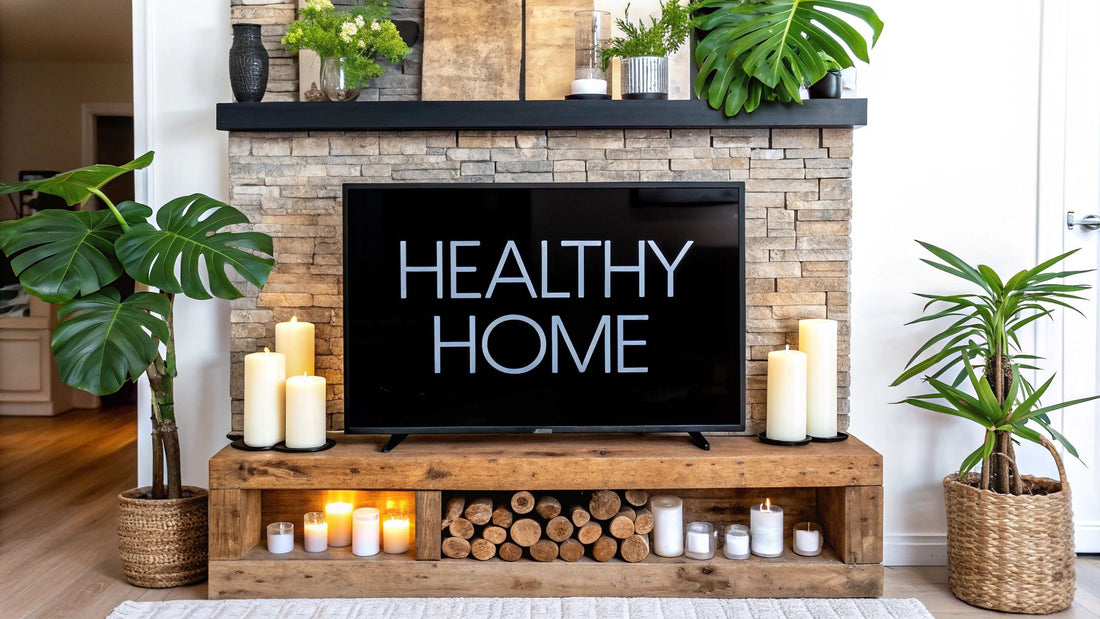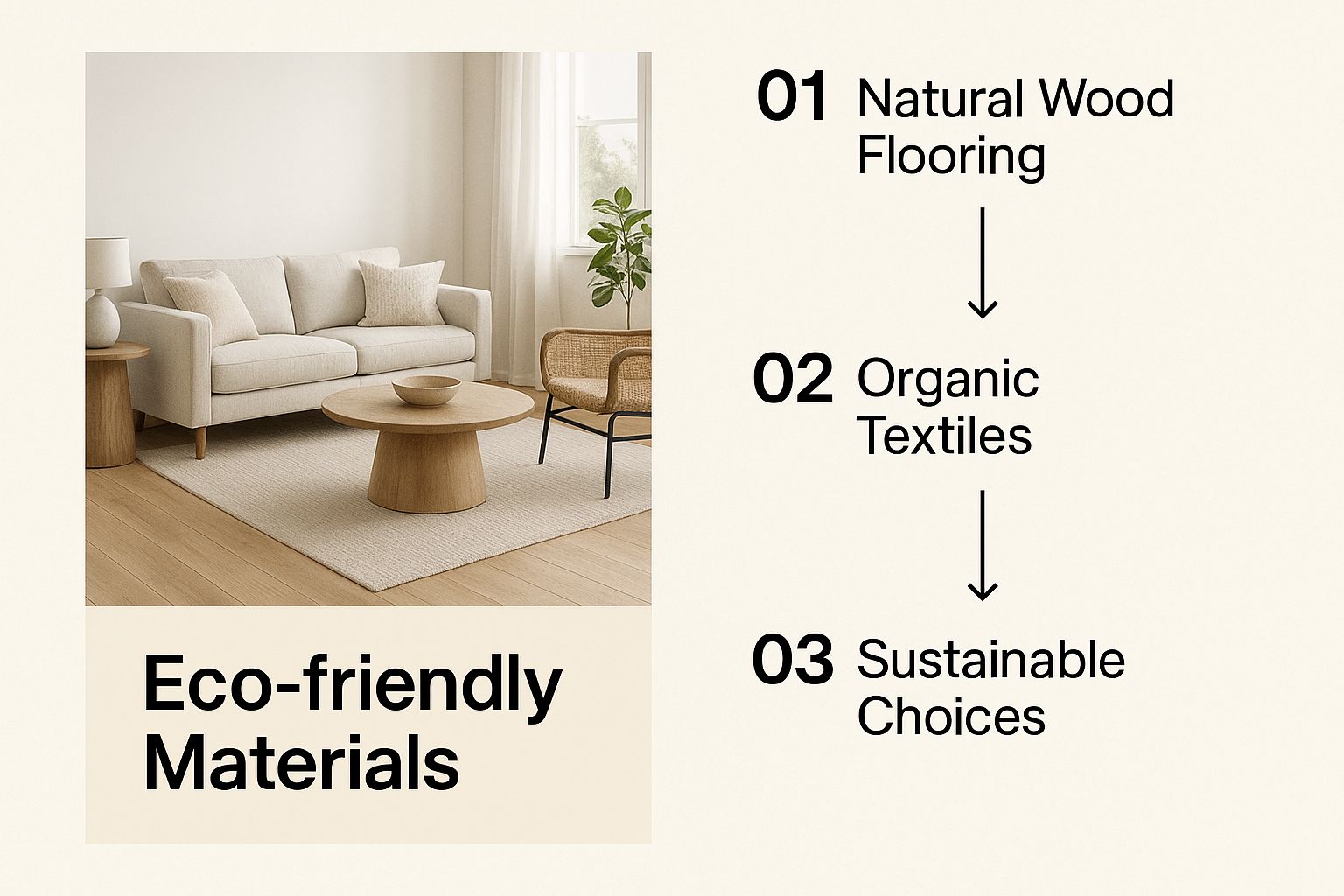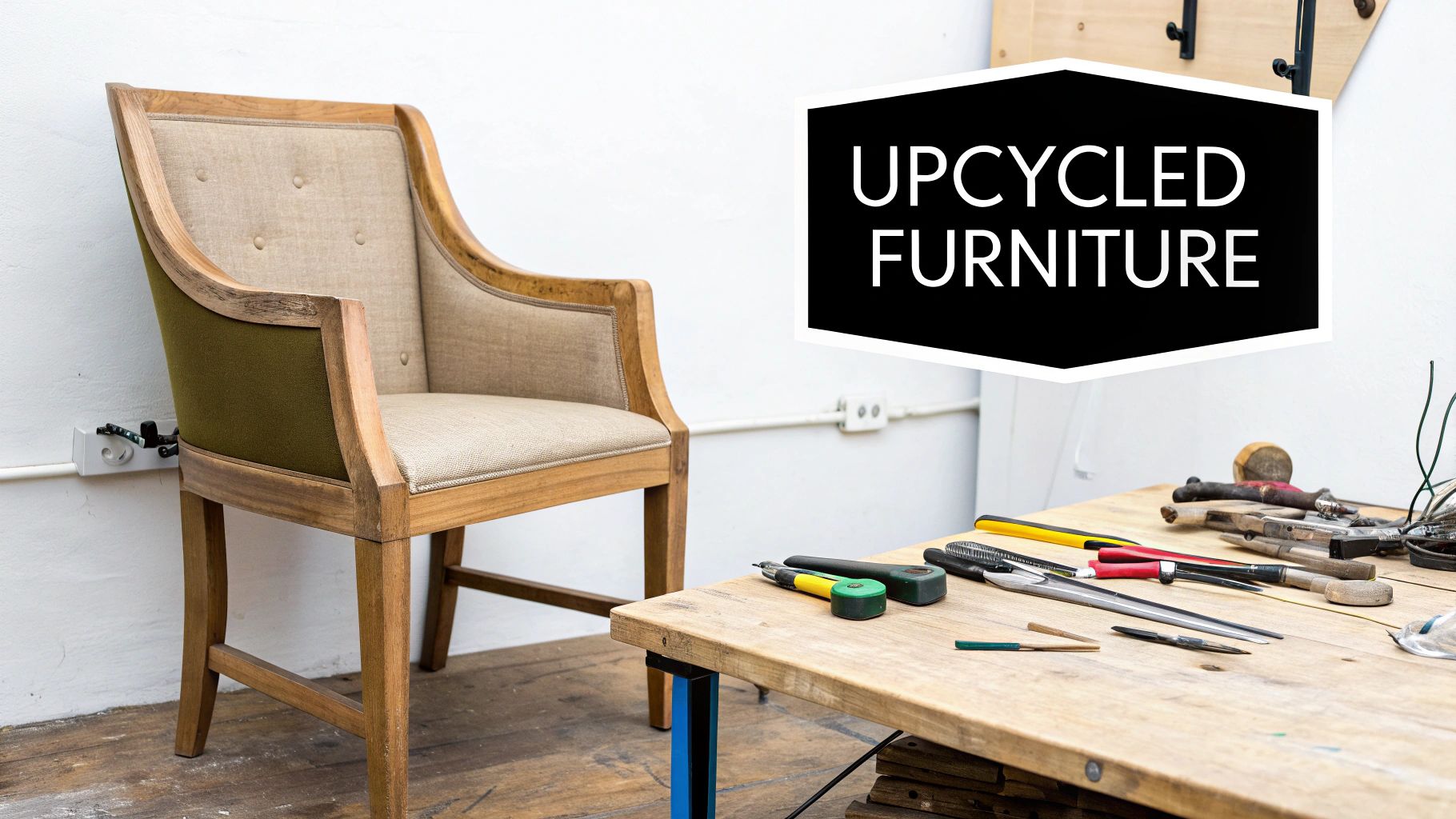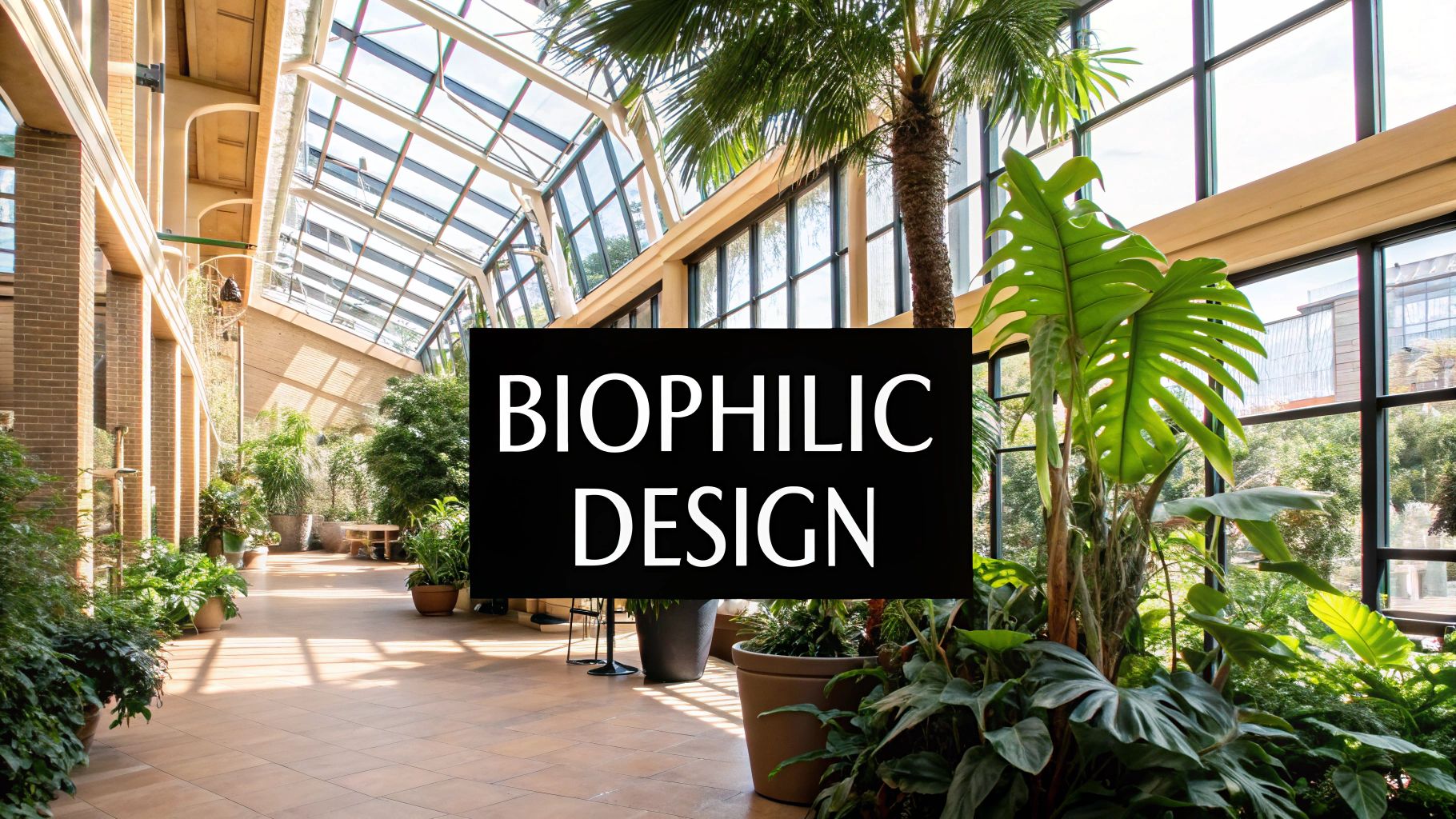
Sustainable Interior Design for a Healthier Home
Sustainable interior design isn't just about a certain "look." It's a genuine commitment to creating beautiful, liveable spaces that tread lightly on our planet. It’s about making conscious, informed choices—from the materials you bring in, to the energy you use, and the waste you produce—to build a healthier home and, by extension, a healthier world.
The Foundations of Sustainable Interior Design
At its heart, sustainable design looks past fleeting trends and focuses on what truly lasts. It’s a design philosophy that marries style with substance, ensuring your home is a reflection of your taste and your values. The goal is to create spaces that are not only beautiful but also durable, resource-efficient, and genuinely good for your well-being.
This approach is guided by a few core ideas that influence every decision, from the bones of a room down to the final decorative touches.
Core Principles of Sustainable Design
Before diving into specific materials or products, it helps to understand the foundational pillars of this design ethos. These principles work together to create a cohesive, responsible, and beautiful home.
| Principle | Focus Area | Practical Example |
|---|---|---|
| Energy Efficiency | Reducing consumption | Designing a room to maximize natural light and installing energy-saving LED bulbs to cut down on electricity. |
| Waste Reduction | Minimizing landfill contributions | Breathing new life into an old piece of furniture by upcycling it, or choosing materials that are biodegradable or easily recycled. |
| Health and Wellbeing | Improving indoor environments | Using non-toxic, low-VOC (Volatile Organic Compound) paints to ensure the air you breathe at home is clean and healthy. |
| Longevity and Durability | Investing in timeless quality | Opting for a well-crafted sofa made from durable, natural materials that will stand the test of time, not just a season. |
Adopting these principles means you start to see your home as a complete ecosystem. Instead of picking a new table just for its colour, you begin to think about its entire journey. What is it made from? What was the environmental cost of its production? Where will it end up years from now? It’s a powerful shift from the mindset of fast, disposable décor to a conscious investment in lasting quality.
This isn't just a niche interest anymore; it's quickly becoming the new standard. I’ve seen this firsthand, especially in places like California, where climate concerns are accelerating the move toward sustainable building and design. In fact, the demand for eco-friendly materials like reclaimed wood has been climbing by roughly 15% each year as more homeowners seek to lower their environmental footprint.
A truly sustainable home nurtures both the people inside it and the world outside. It's living proof that thoughtful design can be beautiful, practical, and deeply responsible all at once.
Even the smallest details play a part in the overall health and feel of your home. The ambiance you set is a fantastic place to start. For instance, choosing candles made from natural waxes like soy, coconut, or beeswax is a simple swap that helps maintain cleaner indoor air. If you're interested in making this switch, you can learn more about the benefits of clean-burning candles and how they fit perfectly into a healthier home.
Ultimately, sustainable interior design is all about empowering you to create a space that not only looks good but feels right—a home that aligns with your values and contributes to a better future.
Choosing Eco-Friendly Materials and Furnishings
This is where your sustainable vision really starts to take shape. Picking the right materials and furnishings goes far beyond just what looks good; it's about choosing pieces that are responsibly made, non-toxic, and designed to last. These choices are the very foundation of a healthy, eco-conscious home.
What you bring into your space directly impacts its look and feel, sure, but it also affects your home's environmental footprint and the quality of the air you breathe every day. When you look past the conventional, mass-produced options, you’ll discover a whole world of beautiful, durable, and thoughtful alternatives.
This visual really captures the essence of how you can use eco-friendly materials to create a space that's not only beautiful but also has a purpose.

You can see how natural elements, like the wood floors and organic fabrics, come together to create a bright, inviting room that truly embodies what sustainable design is all about.
Lean Into Natural and Recycled Materials
At the heart of any sustainable interior is a commitment to materials with a light environmental touch. I always tell my clients to look for materials that are rapidly renewable, made from recycled content, or have been reclaimed from a previous life.
Here are a few of my go-to recommendations:
-
Reclaimed Wood: There's nothing quite like it. Sourced from old barns, warehouses, or factories, reclaimed wood brings a depth of character and history into your home that you just can't replicate. It’s fantastic for flooring, accent walls, or a statement dining table, and every plank you use means one less new tree was cut down.
-
Bamboo: A lot of people don't realize that bamboo is technically a type of grass, not wood. It grows incredibly fast, which makes it a phenomenal renewable resource. It’s also surprisingly strong and durable, making it a sleek, modern choice for flooring, cabinetry, and even countertops.
-
Recycled Materials: We're seeing some amazing innovation here. You can now find stunning countertops made from recycled glass bottles, tiles made from industrial byproducts, and even soft textiles woven from recycled plastics. Choosing these materials is a direct way to keep waste out of our landfills.
And when it comes to paint? The choice is simple. Always, always go for low-VOC or zero-VOC (Volatile Organic Compound) paints. Conventional paints can off-gas harmful chemicals into your home for years, which is terrible for your health. The low-VOC alternatives available today give you incredible colour and quality without compromising the air you breathe.
Choosing sustainable materials is a powerful statement. It says you value not just the appearance of your home, but the health of your family and the planet. Each selection—from the floorboards to the furniture—tells a story of mindful consumption.
The Art of Second-Hand and Vintage Finds
If you want to make a big impact with one simple strategy, embrace pre-loved items. Sourcing second-hand and vintage furniture is the ultimate form of recycling. You're giving beautifully made pieces a second (or third) life and saving them from the landfill.
This approach is all about creating a circular economy right in your own home, keeping things in use for as long as possible. Honestly, vintage finds often have far better craftsmanship than a lot of the fast furniture produced today, meaning they were truly built to last.
Get out there and explore your local thrift stores, antique shops, and online marketplaces like Facebook Marketplace or Kijiji. You can unearth some incredible treasures that will add a layer of personality and story to your home that money just can't buy new. And don’t be afraid to mix and match! A classic vintage piece paired with modern decor can create a truly compelling and personal space.
Boosting Energy Efficiency in Your Home
A truly sustainable home isn’t just about the materials you choose; it’s about how thoughtfully you manage your energy. Making your home more energy-efficient is one of the most powerful moves you can make in sustainable design. The best part? It pays off for both the planet and your bank account. It’s all about smart upgrades that lower your utility bills and shrink your carbon footprint, all without giving up an ounce of comfort.
The goal is to create a home that works smarter, not harder. This means sealing it up tight from the elements, upgrading key systems, and using a bit of tech to cut out waste. These are the changes that directly add up to a more sustainable lifestyle.
Upgrade Your Core Systems
If you're looking for the biggest bang for your buck, start with the heavy hitters: heating, cooling, and hot water. These systems are usually the biggest energy hogs in a home, so tackling them first will get you the most significant savings.
- High-Efficiency HVAC: Today’s heating, ventilation, and air conditioning (HVAC) systems are lightyears ahead of models from even a decade ago. Swapping out an old clunker for a new high-efficiency unit can slash the energy you use for climate control.
- Heat Pump Water Heaters: These are a real game-changer. Instead of generating heat from scratch, they cleverly pull heat from the surrounding air to warm your water. This makes them two to three times more efficient than your standard electric resistance water heater.
This shift toward electrifying home systems is really picking up steam. Down in California's coastal communities like Santa Barbara, we're seeing a huge trend of homeowners going all-in on electric appliances, heat pumps, and high-efficiency HVAC. These aren't just eco-conscious upgrades; they seriously boost a home's market appeal. In fact, properties that include features like rainwater harvesting and greywater recycling have seen their value jump by as much as 10%. You can discover more about these home renovation trends and see how they’re shaping the market.
Seal the Envelope and Embrace Natural Light
Before your HVAC system even has to think about kicking on, there's a lot you can do to control your home's temperature naturally. It all starts with your home's "envelope"—its windows, doors, and insulation.
Upgrading to double- or even triple-paned, energy-efficient windows is a fantastic move. These windows come with special coatings and gas fills that act as a barrier to heat transfer, helping keep your home warmer in the winter and cooler in the summer. That one change can take a huge load off your heating and cooling systems.
A well-sealed, well-lit home is the foundation of energy efficiency. By working with natural light and preventing energy loss, you create a space that is inherently more comfortable and sustainable.
Making the most of daylight is another brilliant—and free—strategy. Think about how your furniture is arranged. Can you position your reading chair to catch the morning sun? This cuts down on the need for artificial lighting during the day. Sheer curtains are also a great tool, giving you privacy while still letting that beautiful light filter through.
Of course, when the sun goes down, you'll need lights. This is where switching to LED bulbs becomes non-negotiable. They use up to 75% less energy and last an incredible 25 times longer than old-school incandescent bulbs. They are an absolute cornerstone of an energy-smart home. To take it a step further, pair them with smart home tech like automated lighting and programmable thermostats. That way, you’re only using energy exactly when and where you need it. No more waste.
Embracing Nature with Biophilic Design
There's something deeply restorative about bringing the outdoors in. It’s a core principle of sustainable interior design, often referred to as biophilic design. This isn't just about scattering a few houseplants around; it's a thoughtful approach that weaves natural elements into the very fabric of your home to create a space that feels calm, healthy, and genuinely connected to the world outside.

The impact is more than just aesthetic. Solid research shows that spaces rich in natural elements can significantly improve air quality, lower stress, and even spark creativity. When you embrace biophilic design, you're not just decorating—you're actively boosting your well-being.
Infuse Your Home with Living Elements
The most intuitive way to start is with living greenery. You can go big or small, from a few carefully chosen pots to an ambitious living wall that becomes a piece of art in itself.
Here are a few ideas I often suggest to clients:
- Create a Plant Corner: Don't just place one plant in a lonely corner. Group several together on a dedicated stand or shelves. Mixing up leaf shapes, textures, and heights creates a dynamic, lush focal point that really draws the eye.
- Start a Kitchen Herb Garden: A sunny windowsill is all you need to grow fresh herbs like basil, mint, and rosemary. It adds a lovely touch of green, naturally freshens the air, and gives you flavourful ingredients right at your fingertips.
- Consider a Living Wall: For a real showstopper, a vertical garden can turn a blank wall into a vibrant, living oasis. Modern systems are surprisingly easy to care for and deliver incredible visual and health benefits.
This trend has become a cornerstone of sustainable interior design, especially in eco-conscious areas. For instance, the popularity of indoor plants has jumped by about 25% recently as more people catch on to the tangible health perks. At the same time, we're seeing over 50% of homeowners choosing modular furniture and other sustainable decor to cut down on waste. You can discover more insights about holistic interior design trends to see how these practices are shaping modern living.
Frame Nature and Maximize Light
Biophilic design extends beyond plants to how your home interacts with the light and views around it. Letting in as much natural light as possible is key. I always recommend swapping out heavy, dark drapes for lighter, sheer curtains. This simple change allows sunlight to pour in, reducing your reliance on artificial lights and providing a natural mood boost.
Also, think about your sightlines. Position your furniture to face windows with pleasant views—whether it’s a leafy garden, a tree-lined street, or simply an expansive patch of sky. Creating that visual connection to the outdoors offers a constant, calming presence throughout your day.
By intentionally designing your space to honour nature, you create more than just a beautiful home—you build a personal sanctuary that supports both your well-being and a low-waste lifestyle.
Finally, think smart with your furniture. Versatile, multi-purpose pieces are a sustainable champion. An ottoman with hidden storage, a modular sofa you can reconfigure, or a dining table that extends for guests all reduce the need to constantly buy new things. This thoughtful approach helps you break the cycle of consumption and waste, allowing your home to adapt and grow with you.
Decorating With Mindful and Sustainable Choices
The final layers of your home's design—the decor, the textiles, the little personal touches—are where its personality truly comes alive. This is your chance to be incredibly intentional, curating a space that tells a story of care and conscious living. Decorating sustainably isn't about giving up on style; it’s about choosing pieces that are beautiful, meaningful, and gentle on our planet.

Instead of reaching for mass-produced items, think about supporting local artisans and small businesses. A hand-thrown ceramic vase or a locally woven wall hanging brings a unique energy and craftsmanship that you just can't find in a big-box store. These pieces don't just decorate a room; they infuse it with soul and support a creative economy.
Curate With Conscious Decor
Sustainable decorating is all about making deliberate choices. It means you’re looking beyond the surface, questioning the materials, and understanding the origins of each item you bring into your home. This practice turns every detail into a reflection of your commitment to a healthier living environment.
A perfect place to start is with ambiance. Did you know that many conventional paraffin candles can release soot and toxins into the air? Making the switch to clean-burning candles made from natural waxes like soy or beeswax is a simple but impactful change. They cast a beautiful, warm glow without compromising your indoor air quality, perfectly illustrating how small swaps contribute to a larger sustainable interior design philosophy.
By choosing decor with intention, you step away from the cycle of disposable trends. Instead, you build a collection of meaningful items you'll cherish for years, reducing waste and creating a home that is authentically you.
This mindful approach is a journey. For a deeper dive into creating a greener home, our guide on eco-friendly home decor is packed with more actionable tips and inspiration.
Embrace Sustainable Textiles
Textiles are what soften a room, adding colour, texture, and a sense of comfort. From curtains and cushions to rugs and throws, the fabrics you choose have a huge impact on both the look of your space and its environmental footprint.
The key is to look for textiles made from natural, renewable, or recycled fibres. These materials are often produced with far less water and fewer pesticides than their conventional counterparts, making them a much kinder choice.
Here are a few excellent sustainable fabric options to look for:
- Organic Cotton: Grown without harsh pesticides or synthetic fertilizers, organic cotton is a win for the soil, the farmers, and your home.
- Linen: Made from the hardy flax plant, linen is incredibly durable, biodegradable, and needs very little water to grow. Its naturally relaxed texture adds an effortless elegance.
- Recycled Fabrics: Innovative textiles made from things like recycled plastic bottles are becoming more popular and accessible. They provide a durable and stylish way to keep waste out of our landfills.
- Wool: As a natural, renewable, and biodegradable fibre, wool is a fantastic choice. It’s also naturally flame-retardant, making it ideal for rugs and upholstery.
When you thoughtfully select non-toxic decor and sustainable textiles, you're completing your design with integrity. Each cushion, candle, and curtain becomes a conscious choice, ensuring your home is a true sanctuary—beautiful, healthy, and mindfully curated from the ground up.
Your Sustainable Design Questions Answered
Taking those first steps towards a more sustainable home can feel like a huge project, but it really doesn’t have to be. People often ask me about the cost, where to find products they can trust, and how to get started without diving into a massive renovation. Let's break down these common questions with some practical, straightforward answers to get you going with confidence.
Is Sustainable Interior Design More Expensive?
This is probably the biggest myth I hear. The idea that going green will always cost you more just isn't the full picture. While it's true some high-quality, eco-friendly materials might have a higher price tag at first, it’s much more useful to think of it as a long-term investment in your home and well-being.
Take durable materials, for example. Gorgeous reclaimed wood or a piece of solid, well-crafted furniture will outlast cheaper alternatives by years, even decades. That means you're not constantly replacing items, which saves you money and cuts down on waste. On a larger scale, things like energy-efficient windows or better insulation can lead to some serious, ongoing savings on your utility bills month after month.
The real value in sustainable design isn't just about aesthetics. It's about creating a home that costs less to run, feels healthier to live in, and is built to last.
And don't forget, some of the most sustainable choices are incredibly easy on the wallet. Hunting for unique second-hand pieces at a local thrift shop or giving a new lease of life to furniture you already own are brilliant ways to inject personality into your space without spending a fortune.
Where Can I Find Trustworthy Sustainable Products?
Sourcing genuinely sustainable goods is much easier these days, so long as you know where to look and what to watch out for.
I always suggest starting local. Exploring artisan markets, craft fairs, and even online platforms that feature independent makers is a fantastic way to find unique, handcrafted items with a real story behind them. When it comes to building supplies, look for vendors who specialize in materials like reclaimed wood, recycled glass, or rapidly renewable options like bamboo and cork.
When you're shopping at bigger stores, it's time to become a bit of a detective. Get used to reading the labels and looking for certifications that help you see past any "greenwashing." Here are a few I always trust:
- Forest Stewardship Council (FSC): This is your guarantee that any wood or paper products have been sourced from responsibly managed forests.
- GREENGUARD: Seeing this logo means the product has low chemical emissions, which is a huge win for healthier indoor air.
- Fair Trade: This certification tells you that textiles and other goods were produced ethically, with fair wages and safe conditions for the people who made them.
How Can I Start Without a Full Renovation?
You absolutely do not need to tear down walls or commit to a complete overhaul to make a real impact. Small, consistent changes are incredibly powerful and they truly add up over time.
Start with a few simple swaps. When your old lightbulbs burn out, replace them with energy-efficient LEDs. Bring in a few houseplants—they're nature's air purifiers and an easy way to add a touch of biophilic design. For creating that perfect cozy atmosphere, choosing a beautiful natural home fragrance from clean-burning candles instead of synthetic sprays makes a world of difference for your air quality.
From there, just make it a habit. Each time a piece of furniture gets worn out or an appliance gives up, make a conscious choice to replace it with a more sustainable and efficient option. It’s these small, deliberate steps that will gradually transform your space into a much greener and healthier home.
At Shivora Candles, we believe that creating a beautiful, sustainable home should be an accessible pleasure. Explore our collection of hand-poured, clean-burning soy wax candles to find the perfect scent for your sanctuary. Discover your new favourite fragrance today.
